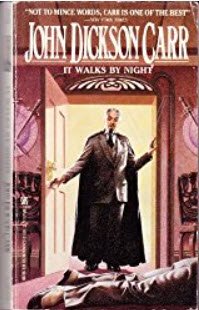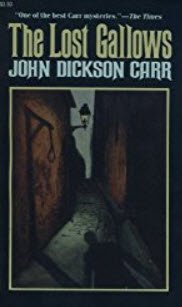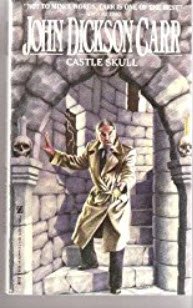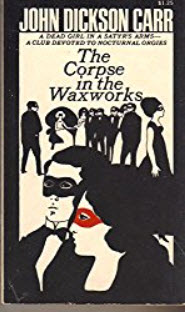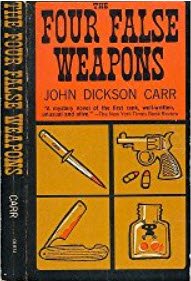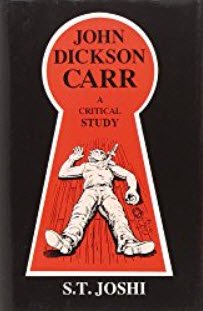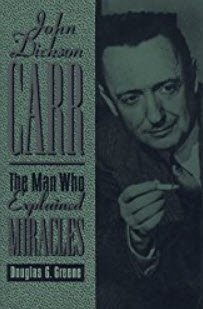Henri Bencolin
"Mr. Carr can lead us away from the small, artificial world of the ordinary detective plot into the menace of outer darkness. He can create atmosphere with an adjective, and make a picture from a wet iron railing, a dusty table, a gas-lamp, blurred by the fog. He can alarm with an illusion or delight with a rollicking absurdity....Every sentence gives a thrill of positive pleasure."
-- Dorothy L. Sayers
Henri Bencolin -- Mephistophelian, satanic, and cruel. John Dickson Carr's first published novel (of more than seventy books!) featured Bencolin.
Carr (born in Uniontown, Pennsylvania, USA, on November 30, 1906; died in Greenville, South Carolina, on February 27, 1977), thought it would more likely interest readers if he created an unlikeable character. S.T. Joshi indicates the idea is that "...if he terrifies ordinary people, he will certainly terrify the guilty" (John Dickson Carr: A Critical Study, Copyright ©1990 by Bowling Green State University Popular Press, p. 10).
Young John Dickson Carr Loves to Read
It had taken Carr some time to develop Bencolin. He discovered early in life that he loved to read. Privileged to have access to his father's library, he was exposed to the classics.
He loved The Arabian Nights, the works of Alexandre Dumas (The Three Musketeers and many more) and the Wizard of Oz series by L. Frank Baum. He also read Sherlock Holmes stories, Thomas Hanshew's detective Hamilton Cleek ("The Man of the Forty Faces") and Gaston Leroux's novel The Mystery of the Yellow Room (which he later wrote--in the famous "Locked Room Lecture"--was "the best detective tale ever written").
When he discovered G.K. Chesterton's Father Brown stories, he absolutely loved Chesterton's use of paradox.
A natural outgrowth of Carr's love of reading was a developing penchant for writing. His earliest efforts were to create swashbuckling tales of adventure, ghost stories and, later, detective stories. He didn't care for novels of manners and customs (such as those by Jane Austen) and he despised works by writers of so-called "realism" (such as those by Ernest Hemingway, Sinclair Lewis, and Marcel Proust).
When he was fifteen, he wrote an essay, published in the Uniontown Daily News Standard, in which he criticized such writers. (Douglas Greene reprinted it in John Dickson Carr: The Man Who Explained Miracles, pp. 454-5.) Carr was also publishing stories in the high school literary magazine (The Hill Record).
Writing -- Even More Fun Than Reading!
His father, Wooda Carr, was an attorney (and, for one term, a congressman). Wooda wanted young Carr to follow in his footsteps and become a lawyer, too. Wooda sent John to The Hill school.
He did reasonably well during his first year at the Hill school. After that, his grades started to suffer. He continued to excel at writing assignments but he abhorred mathematics. And he continued to write stories in earnest for The Hill Record. Classmates recall that they heard him pounding the typewriter keyboard at all hours of the night and would often show up in classes a bit bleary-eyed the next day. Douglas Greene writes, "Carr's detective tales at The Hill School had been the least accomplished of all his juvenile works, but although the solutions often strain credulity, the early cases of Henri Bencolin, prefect of Paris, would be worthy of many writers past the journeyman stage and aspiring to become masters" (John Dickson Carr: The Man Who Explained Miracles, p. 50).
Wooda Carr tried to encourage his son to study more and attempted to redeem his poor grades by having him transferred to Haverford, which was known for preparing its students to enter Harvard University.
But Carr continued to pursue his writing and took up extra-curricular activities such as fencing. In June 1926, he became editor ofThe Haverfordian, the college's literary magazine.
Carr wrote many stories for The Haverfordian He and fellow student Frederic Prokosch wrote the entire "Chapbook" issue of The Haverfordian (1926). This issue was anonymous but initials of pseudonymous authors were included at the beginning. The issue included eight "legends" and a framing story.
In June 1927 Carr obtained a passport and boarded a ship to England. From there, he took a plane to Paris. During his stay (he returned to the States in January 1928), Carr traveled through England, Germany, and Italy. In Paris he was exposed to the "Grand Guignol."
Henri Bencolin--"Mephistopheles Smoking a Cigar"
When Carr returned from Paris, he met with his father, who agreed to give him a year to establish a writing career. He then wrote a 25,000 word novella called "Grand Guignol," which featured Henri Bencolin. Part 1 was published in The Haverfordian in March 1929; part 2 was published the following month. Greene tells us that Bencolin is depicted on the cover of part 2 as "suavely Mephistophelian." In "Grand Guignol," he is described as "Mephistopheles smoking a cigar." Bencolin is "Paris's avenger of broken laws."
|
Click Image to Click the image below to |
This is the story that Carr developed into It Walks By Night and brought to Harper & Brothers. It became his first published book (of more than seventy!). Joshi says "Bencolin's personality is already established in these, undergoing only elaboration in the novels" (Joshi, p. 9). But Greene tells us that Bencolin had been depicted as kindly in the early stories. In "Grand Guignol," says Greene, Bencolin is "almost soulless" (John Dickson Carr: The Man Who Explained Miracles, p. 69). In It Walks By Night (Carr's first published book) he is satanic and cruel, almost inhuman. And he seems to delight in his cruelty. |
Greene tells us that Carr wrote four detective stories and a novella featuring Bencolin during this period. He also used Bencolin as a character in the framing story for "The New Canterbury Tales." (Greene p. 52.) Bencolin is prefect of police, later to become juge d'instruction.
Bencolin Interlude
Once It Walks By Night was published, Carr's writing career was established. After four Bencolin books, Carr developed other detective characters (e.g., Dr. Gideon Fell, Henri Merrivale, Colonel March, and others). By this time, Carr thought Bencolin was too overpowering and wanted to create a softer, more likeable detective. He did so when he created Dr. Fell. As he continued to write, he produced books that included the following:
- Poison in Jest (featuring Patrick Rossiter)
- 7 Gideon Fell novels
- The Murder of Sir Edmund Godfrey (1936)
- The Burning Court (1937)
- 5 Henry Merrivale novels (writing as Carter Dickson)
Return to Bencolin
During this time, Carr began to write a book that would bring Bencolin back (Vampire Tower) but he developed it into a Fell novel (The Three Coffins). Later, after writing The Burning Court, he did bring Bencolin back in The Four False Weapons (1937). He toned Bencolin down. Coming out of retirement, Bencolin can reveal that his personality was largely an affectation. Douglas Greene writes, "After the false start in Vampire Tower (which he had rewritten as The Three Coffins), Carr realized that he could not bring back the satanic Bencolin who had enjoyed tormenting his prey. The original Bencolin of Carr's college stories, however, had been gentle, amiable, and even a bit shambling. If Bencolin were to come back to life, he would have to be that original Bencolin" (Greene, John Dickson Carr: The Man Who Explained Miracles, p. 173).
The following scene is from The Four False Weapons. In it, Henri Bencolin is talking to Richard Curtis and Bryce Douglas:
| "...The odd part of it consists
of this: I know who the murderer is. I can even prove who the murderer is. And
therefore I am at an absolute dead-wall and dead-end."
Curtis wondered whether he had been hearing aright. "Hold on!" he protested. "You say you know who the murderer is, and can prove it, and therefore you're stumped? Is this some kind of play on words?" "No. It is the plain and painful truth. And, unfortunately, it is no credit to me that I know the murderer. There were one or two little indications which led me to think so, yes: I looked for the proof: and there it was. If you think I'm talking wildly, let me state a similar case. Suppose you are reading a detective story with an intriguing situation. A corpse (let us say) is found strangled, sitting in a chair by a window, and wearing a domino mask; and all the clocks in the house are found with their faces turned to the wall. You are carefully warned that the blazing clue to the truth is the fact that there is a teaspoon in the victim's side pocket, and that, without all these things being just as they were, the crime could never have taken place.--You follow me? No clue was left merely to confuse; or because it was a reminder of the victim's past misdeeds (that saddest device of all); or because the murderer thought it artistic. Each indication was a necessary part of the pattern." "What's the explanation?" demanded Bryce, his face lighting up with interest. Bencolin looked at him. "I suggest you think of one," he said politely. "Or apply yourself to a study of Rose Klonec's murder. But to finish this mask-clock-teaspoon puzzle. Now, suppose at the denouement the identity of the murderer was revealed--for the simple reason that his fingerprints matched those on the collar of the strangled man. Would you feel cheated? That's exactly what might happen in life; but would you feel cheated? You know damned well you would. There is no doubt as to the identity of the murderer. He admits the crime. Then he shoots himself. Consequently, you never know the significance of the mask or the reversed clocks, or what deduction you should have drawn from the teaspoon. Page 315, 'The End.' What would you do? You would strangle the author, lynch the publisher, and shoot the bookseller. Yet why do you complain? You know the identity of the murderer, don't you?" |
The Bencolin Books
Five novels feature Henri Bencolin:
- It Walks By Night (1930)
- The Lost Gallows (1931)
- Castle Skull (1931)
- The Corpse in the Waxworks (1932)
- The Four False Weapons (1937)
|
Click Image to Click the image below to |
Click Image to Click the image below to |
|
Click Image to Click the image below to |
Click Image to Click the image below to |
|
Click Image to Click the image below to |
John Dickson Carr: A Critical Study by S.T. Joshi covers the following topics:
|
|
John Dickson Carr: The Man Who Explained Miracles by Douglas Greene is the definitive biography of Carr. Greene put more than a decade of research into this indispensable volume, which discusses the seventy Carr novels, dozens of short stories and radio dramas. Carr, a giant of the Golden Age of detective stories, counted among his friends Dorothy L. Sayers, Ellery Queen, Agatha Christie, and others. Includes a Checklist of the Works of John Dickson Carr. |
Click Image to Click the image below to |
Amazon and the Amazon logo are trademarks of Amazon.com, Inc. or its affiliates.
(This is a link through which I make a small commission if you buy. See here for more details.)
